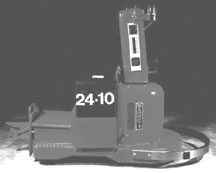 Savant's first AGV |
Automated guided vehicles (AGVs) is not a new technology; it has been around since the '50s, helping companies save time, money and labour. It is only now in the 21st century that this materials handling option is evolving and coming into its own.
Also known as laser-guided vehicles (LGV) or self-guided vehicles (SGV), AGV technology has become a more sophisticated and reliable option to transport goods.
Yves Gazin, vice president of products and solutions at US-based industrial automation solutions provider Egemin Automation, says interest in the technology is cyclical. "We are currently at the beginning of a new increase in use that is being driven by the progressing technology opening up new markets and places.
"Egemin has no doubt that the next five years will show phenomenal and fundamental changes in the AGV industry, making the AGV as a product very important, if not the most important component of a successful manufacturing and warehousing environment."
Anselmi Immonen, vice president, customer projects for Rocla Oyj, says the AGV market has been stable for many years and is considered a niche area. "Compared to forklift market it is not much."
"I have the feeling it is the time for innovations in this area to grow," he says. "I have identified three global mega trends in automation - technology price, labour force costs and traceability of the process, which will contribute to this growth."
"2010 will be the decade of AGVs," he predicts.
AGV backgroundBarrett Electronics of Northbrook, Illinois, (now Savant Automation of Walker, Michigan), introduced the first AGV to the market. At the time, it was as simple as a tow truck following a wire in the floor instead of a rail. Savant developed a 'track' for the vehicles to follow by embedding a wire in the factory floor.
Sensors on the bottom of a tow truck looked for a magnetic field. The field was created by a current running through a wire or series of wires in the floor. Station codes consisted of an array of magnets (north/south combinations) in the floor that a vehicle would read.
During the '70s, solid-state controls were developed and the capability of AGVs expanded. The options for this technology moved from just towing functions to delivering loads and transporting goods around a warehouse and automotive assembly systems.
Savant says the wire in the floor is still available but "many systems today are being designed without the floor wire. "Vehicles are now equipped with sophisticated computers on board to communicate, direct and manage the system."
How AGV worksAllan Frydman, a Sydney, Australian-based senior system design engineer for Swisslog, says AGVs are essentially computer-controlled forklifts. "Instead of a person making the decisions, a computer program tells the forklift where to go.
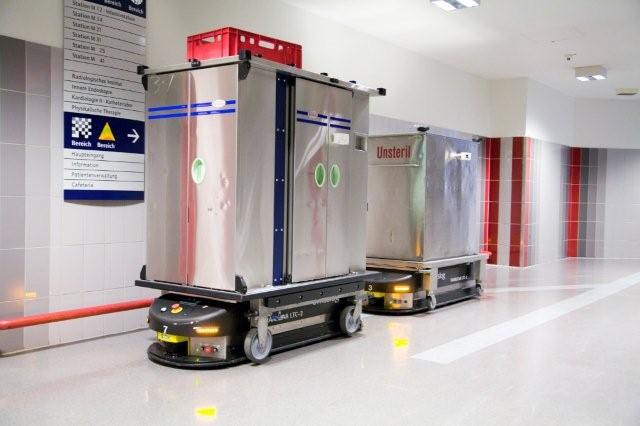 A Swisslog AGV transporting food in a hospital |
"Typically, they will have a laser on top of them, which is reflected around the warehouse," he explains. "The AGV is able to locate where it is by the lasers seeing its position through the reflectors."
Frydman says AGV technology is based on the same idea as GPS, but "instead of reading to a satellite, it is reading to reflectors in a warehouse".
"You can configure the path of the AGV through the computer."
AGVs can replace a standard forklift and human driver, for example, when there are difficulties loading trucks, and for work environments where it is uncomfortable for humans to work, like cold and hot storage.
AGVs are computer-controlled vehicles with onboard microprocessors. Most AGVs have system management computers that give transport orders, track the goods being transported and direct the AGV traffic.
Advancements in AGVsAs with any new technology, there have been changes over the past 50 years but the most significant changes have occurred over the past two years. Many of the leading AGV companies have introduced new products on the market to capitalise on the changes in AGV options.
Gazin says the AGV market has seen two major changes in the last two years in terms of technology and application: "The introduction of more advanced sensing technology for safety and navigation offers more intelligent and reliable AGVs," he says. "The change in application has been the successful realisation of over-the-road trailer loading by AGVs, which opens up a whole new market segment."
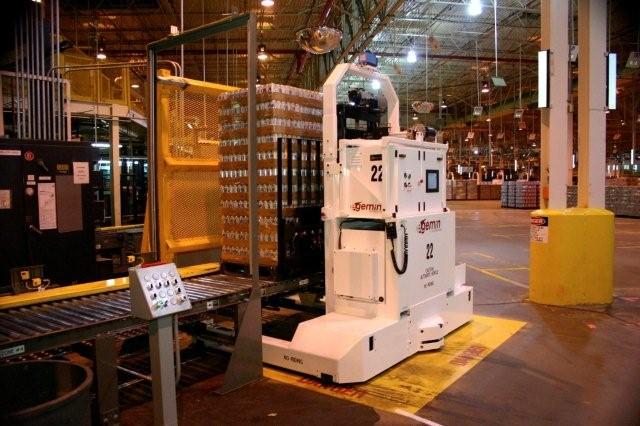 Egemin's FLV used to transport beverages |
Gazin explains that the technology has created the possibility to take AGVs into applications where there were major challenges, such as truck loading. "The truck loading has created a renewed interest in the AGV as a product."
Greg Cronin, executive vice president at Seegrid Corp, a US-based industrial mobile robotics developer, says the company has created an entire new category of driverless machines for the materials handling industry that "leap frogs" current AGV technology.
"The company's G Series industrial mobile robots use vision-guided and artificial intelligence (AI) software-driven robotic technology to navigate materials and pallets through warehouses, distribution centres and manufacturing facilities," he explains.
"Unlike AGVs, the robots use no lasers, tapes or wires. Because they are software-driven and use off-the-shelf camera and computer components, they are easy and more affordable to install, operate and repair. Due to the low price point in the market relative to AGVs, customers often see a payback of six months or less."
Seegrid's GP8 is a robotic pallet truck that automates the long-haul transport of pallets. Cronin says an operator simply positions the GP8's forks under the pallets and the robot does the rest. "The robot transports the pallets to the assigned location, then automatically positions the pallets and returns to the original starting point (or another pre-assigned location) for more work."
Peter Davis, marketing office for Australian supplier of turnkey robotic systems Robotic Automation, says there have been three areas of change. "Trailer-loading AGV applications are of great interest," he says. "Standard road trailers are able to be loaded without changes to the trucks or loading docks, with no bulk conveyors and no plant modifications needed."
The second change, according to Davis, has been the refinements to drive motors, controls, and power. Davis says these changes have allowed the size of each vehicle to be reduced for optimum maneuverability. "So there is more intensive use and layout of plant space.
"System interfacing and vision sensors are also much more refined, allowing new AGV applications in tending loads through other processes plus multi-stage perception of obstacles for greater safety and movement efficiency."
Davis says existing AGV users have continued upgrading from older wire-guided AGV fleets to the more flexible laser-guidance technology. "(Laser-guidance) was the last major innovation that brought AGV systems back into prominence," he comments. "It allows for quick changes to AGV movements without digging up the flooring."
Robert Sanders, sales manager at C&D Skilled Robotics in the US, says the transition to high-bay storage LGVs has enabled facilities to utilise their valuable floor space more efficiently.
Tom Currier, major accounts manager for LiftOne Engineered Solutions in the US, says the vision-based technology developed by Seegrid is one-of-a-kind.
"Conventional guidance for AGVs can include wire, tape, and laser/reflectors," he says. "Seegrid's vision-based system will certainly change the way customers think about automation because of the flexibility it offers the end-user. Routes can be changed quickly and easily and the unit is back in service in no time."
Tomas Angervall, product line manager for AGV System, Danaher Motion in the US, says the biggest change the company has seen is the demand for solutions in a range of different applications.
"We see an increasing demand for AGVs in outdoor and cold storage applications," he says. "To meet this demand, we have introduced a laser navigation sensor that is IP65 classified."
Monty Taylor, CCV program director for Sky-Trax in the US, says there appears to be a trend toward increased flexibility. "Fixed routes and fixture pick-up/put-down points are viewed as barriers to AGV entries in a great deal of applications."
Sky-Trax provides a navigation method that can be used by both manned and un-manned vehicles within a facility. Using the same method to know where everything is, the manned system can pass off workloads to the unmanned system. The Sky-Trax system can provide collision avoidance and actively change the AGV routes to avoid collisions with manned vehicles.
Industry application of AGVAGVs can be used in a range of industries and can replace forklift operators in certain environments or can complement conventional forklift operations.
Egemin has found AGVs are used in many industries "including, but not limited to, automotive, food, beverage, pharmaceuticals, paper, newsprint, any kind of manufacturing and warehousing, freezers, and hazardous environments," Gazin explains. "Basically anywhere a load or product needs to be moved from point A to point B."
Sky-Trax's Taylor agrees that AGVs are being used in a range of new areas. "AGVs appear to be moving from their origins in manufacturing into a number of new arenas," he explains. "Applications within distribution and warehousing are occurring and still to come are automated road vehicles - where tremendous progress has been made in the last few years."
C&D Skilled Robotics' Sanders says all types of industries from food and beverage to tyre and rubber, are embracing LGV solutions. "Changing from manually operated forklift drivers to LGVs is an easy transition because there is very little site preparation needed and the forklift lanes are already in place."
Seegrid hopes to use its vision-guided technology to move AGVs out of typical manufacturing environments to other distributors. Cronin says AGVs have been used to carry raw materials or finished goods on routes that will be in place for extended lengths of time.
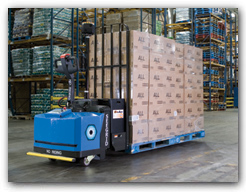 Seegrid GP8 can store unlimited paths |
"We hope to engage with third party distributors and grocery organisations," he says. "Because this sector of the market can change so rapidly, depending on their customers' requirements, they will need the flexibility to change delivery routes quickly."
Seegrid's Cronin says its robots can work in any manufacturing, warehouse and distribution environment. "The company has seen much activity and interest in grocery, retail, 3PL (third-party logistics companies) and automotive industries," he comments.
LiftOne's Currier says the food industry (cold storage applications) and the port industry (container transportation) are showing interest in using AGV applications.
Robotic Automation has found the paper processing and newspaper-printing industries have been the first to embrace the technology in Australia. "The automotive (industry) is a close second and the food and beverage have recently made a big push into this area," says Davis. "All these industries have been strong users of robotic systems at the end of their production lines - to pack, palletise, and stretch-wrap the pallets.
"Using AGVs is really just an extension of that - the 'last link in the automation chain'. Now the production line has a fully automated link into warehousing and despatch areas and interfaces with warehouse management systems the whole time. The cost, efficiency, and safety benefits are substantial."
AGVs vs forkliftsWith the increased interest in AGV technology and the range of applications and industries it can be used in, will AGVs replace forklifts?
Companies considering the use of AGVs need to evaluate the work environment it will be used in and the other individual requirements of the warehouse. The benefits to be considered include savings in labour costs and reduction of injuries and accidents that often occur with manually operated forklifts.
AGVs typically require a short set-up time and do not require someone to operate them. Currier says the ROI on Seegrid's products can be as little as six months. "With very little human interaction, Seegrid's robots accomplish tasks just as a manually operated forklift with reduced operating costs, being a major benefit to users of Seegrid robots."
Egemin's Gazin believes an AGV is an excellent replacement for a forklift since it executes the same function, eliminating some of the potential issues related to forklifts. "(Benefits include) increased safety, continuous operation - AGVs don't need a break or have lunch - 100% tracking of what they are doing in real time and labour savings when implemented properly," he explains.
"One aspect initially seen as a shortcoming is their lower speed. Eventually the end-user will come to see this as an advantage since it increases safety, lowers maintenance cost and increases reliability."
Rocla's Immonen says when you look at western Europe and countries with similar economies, the labour cost for a driver is about USD40,000 per year, plus cost damages to the forklift and goods. He says using AGVs is more cost effective for companies.
"With less people on labour market, it is already hard to find skilled labour and if they are skilled, they can damage equipment," he explains.
"However, the AGVs price is about the same over the last five years. When you take into account inflation and the cost of computers and microchips, it has become cheaper."
Sanders says LGVs offer a safer and more efficient working environment and can work 24/7, 365 days. "They are generally justifiable if the facility has at least one forklift driver per shift, three-shifts-per-day, five-days-a-week," he says. "LGVs are designed for repeatable tasks. This means some facilities with minimal forklift traffic or tasks that change throughout the shift may not be a good candidate for LGVs."
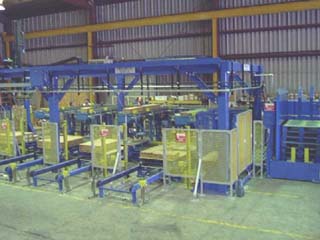 C&D Skilled Robotics gantry robot |
Davis says the benefits are scaleable with the fleet size. "(Users) don't often replace a single forklift with an AGV system."
Davis says that "while it's easy enough to re-program an AGV's movements, for those non-routine or ad-hoc forking needs about the facility, it's much faster to get a driver on a forklift to do it".
"When it comes to the routine movements of finished goods from palletiser to pallet-wrapper to warehouse to despatch to truck - AGVs are ideal here."
"Where a driver becomes bored by routine and easily distracted, threats to safety and quality creep in, but AGVs thrive on routine," he explains. "With a central management system to automatically direct the vehicles where they're needed most, movements can be made more efficiently, consistently, and safely - 24 hours/seven days - without bottle-necks, without breaks, without damage to the loads, the infrastructure, the vehicles or the staff."
Angervall from Danaher says in many cases AGVs are good replacements for forklifts. "When doing an ROI calculation, you often find a significant gain when there are many transport tasks that can be performed during and outside office hours."
Taylor says there are many factors involved in deciding whether a manned forklift application could be replaced by an AGV. "In any forklift application, the driver is normally the most expensive portion of the cost of the vehicle's operation," he says. "In a seven-day, 24 hour operation, the driver cost can easily be 80% to 90% of a USD200,000 per vehicle operating cost.
"Even a very expensive AGV can provide significant ROIs. The difficulties or perceived costs in AGVs are generally related to the fixed nature of them. Reprogramming and reteaching are considered difficult, time consuming and expensive. New AGV technologies must be focused at eliminating these barriers."
AGV market shareMost of the companies Forkliftaction.com News spoke to acknowledged this section of the materials handling industry is beginning to blossom. As more and more industries consider the use of AGVs, its market share will grow.
Angervall says outdoor transportation and cold storage are areas where Danaher expects to see AGVs take market share from forklifts in the coming years.
Seegrid has created a new category beyond the AGV market and does not yet have any market share data or statistics on the size of the market. The company expects to see increased interest in AGVs during the economic downturn due to decreased staffing and reduced operating budgets.
Egemin does not yet have clear statistics on the overall adoption of AGVs in the warehouse environment. Gazin says until recently most AGVs have been implemented in the manufacturing environment. "With the technological improvements and the entry in truck loading, an enormous new potential is created for AGVs in the warehouse environment.
"Guessing at numbers, I would say currently less than 1% of the warehouses in the US have some kind of AGV implemented."
Robotic Automation believes there will always be a dominance of forklifts in the SME market (small to medium size businesses). Davis says this still leaves the AGV market with a lot more room to grow. "At the bigger end of town in Australia, we've recently seen about 25 AGVs per year taken up in the manufacturing industries. Companies like FMC Technologies has over 3,000 AGVs installed worldwide.
Davis says there are several broad factors underlying the widening use of AGVs in Australia. "Manufacturing becomes even more competitive for the western countries as China and Asia continue to grow," he says. "The price of AGV technology has come down. Plant modifications are no longer necessary for AGV installation. Laser-guided AGVs can be reprogrammed in-house for changing production needs without extra costs."
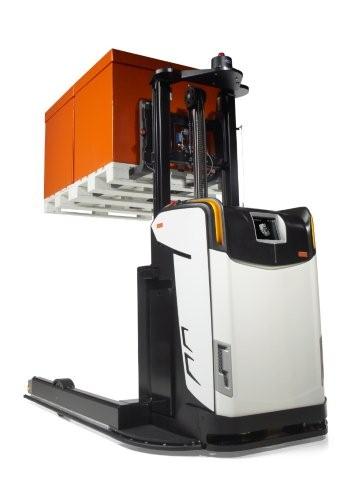 Rocla's AGVs are being used by the newspaper industry |
Immonen says industries like newspaper publishers and beverage are using AGVs to great effect.
Customer needsWith economic hard times looming for many businesses, end-users are looking for value for money and ways to cut costs without sacrificing productivity and customer service. AGV manufacturers and suppliers believe the use of this technology can save companies time and money.
Coca-Cola Amatil's Jeff Maguire says that the Australian beverage giant has only just commissioned the AGV to pick and place on a palletiser and in-feed for the warehouse. He says CCA decided to trial the AGV system after seeing them in operation in other global locations and liking what they saw.
Currier says customer demands are changing relative to decreasing operating costs, especially in challenging economic times.
Egemin's Gazin says the change in customers' needs will relate to AGVs evolving from standalone systems to fully integrated systems in the supply chain. "Providing WMS (warehouse management system) capabilities is important for AGV vendors and allows them to tie into the existing infrastructure on the floor - conveyors and palletisers - and the existing business systems and manufacturing execution systems."
Davis says the challenge is always to do more with the technology. "If an AGV can drop a loaded pallet to the despatch department, why can't it also load the trucks as well?" he asks. "Now it can.
"If a customer wants to make better use of warehouse space and stack loads accurately to five metres high, AGVs can do it."
Robotic Automation envisages more user-friendly programming with the introduction of laser guidance. "AGV installation and vehicle path changes can be made without plant floor modification," Davis says. "With more customers to take advantage of this new flexibility, there will be further opportunities to reduce costs by making it easier for customers to do their own vehicle programming."
The next big thingDanaher's Angervall says the next big thing for AGVs will be port applications (container transportation), AGVs built on standard components and vision navigation.
LiftOne's Currier says the next development on from vision navigation will be the ability to have the robots interact with each other and perform order-picking and related tasks.
Seegrid's Cronin says as the robots become more autonomous, they will be able to do other tasks such as picking, put-away, replenishment and other functional tasks that will free up employees for other value-added work.
Egemin is focusing on the impact of AGVs in the future. Gazin says from a performance point of view, major improvements will be seen in the reliability of using new technologies and tapping knowledge from non-AGV industries to apply to Egemin's product.
"Safety is constantly evolving and all vendors providing us with safety sensors are working hard on taking sensors from a two-dimensional world (a safety plane) into a three-dimensional world to sensing objects as volumes," he says. "This will be a major step forward for the AGV industry.
"AGV productivity will increase through the connection with the existing systems allowing for smarter, more flexible execution of tasks."
Rocla's Immonen says he would list interface user friendliness is an area that still requires improvement. "We have put a lot of focus into the automation, but sometimes you need use the screen, move a pallet from the wrong place, so it needs to user friendly so the process can be restarted.
Immonen says automation needs to be brought down to the level where it is not something special and it can be understood. "It is not rocket science and we do not want it to be something special.
"Many warehouse mangers do not want to know about AGVs because of its reputation as being niche and unreliable," he explains. "They do not know the technology of today and do not understand the process of AGVs.
"We are selling a logistics solution - a complete solution - not just an AGV."
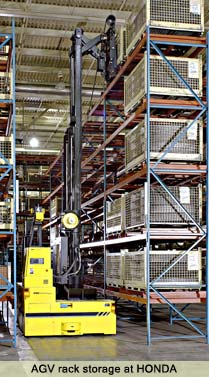 Robotic Automation's rack storage AGV |
Robotics' Davis believes AGVs are set to become smarter than ever before. "Advanced processing and 'learning' is done onboard each vehicle," he says.
"Essentially each of these 'Smart AGVs' from FMC now has its own powerful PC-brain instead of being limited as a simple drone to the AGV management system.
"The implications are for improved efficiency and productivity. Each AGV can 'learn' of variations in expected layout positions, new obstacles and the paths around them etc, and then pass that 'learning' on to all other AGVs.
"Perhaps the ultimate potential of 'Smart AGVs' on the largest scale is a driverless street-registered AGV road-trailer - doing (a freight run between major cities) with a mix of long-range GPS navigation and shorter-range vision systems on-board, giving us a dramatic reduction in truck-related fatalities," he predicts.